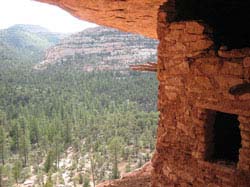Xeric Choices: Xeriscape Basics & Ancient Ideas

Home landscapes can happen by accident. Lack of time, money, energy and thought all can contribute to a crazy quilt of a garden plan with owners impulsively and intermittently adding plants randomly throughout their yards without considering plant needs.
Sometimes these choices work well; other times plants fail to thrive or become invasive and harm other plantings. However, to create a successful xeriscape garden, planning and design are essential. A little bit of wisdom from ancient Native American practices doesn’t hurt either.
Mapping Your Domain
The first step in xeriscape is to draft a map of what exists – plants, structures and water sources -- in the area you want to renovate for greater water conservation. Planning helps you make better choices, which saves time, money and effort as well as water.
Matters to consider include analyzing what areas of the yard are sunniest, shadiest, dampest and driest. Regarding existing plants, you need to determine which water hogs should stay and which should go. Then you can begin deciding how to create zones in the yard for varying levels of watering and select new plants appropriate for those areas.
This planning process won’t happen in a day.
Improving the Soil
Amending garden soil with organic matter, such as compost, is rarely a mistake. It can make life easier for many plants in low-water conditions, because organic matter increases soil’s ability to hold moisture and drain properly. It also encourages tunneling by earthworms, which improves soil nutrients, aeration and access to water.
However, when zoning parts of your yard for xeric Salvias, don’t overdo the amendments, because many Salvias prefer less rich soils. Also keep in mind that native plants do best in local soils.
For example, the ancient Tongva indians (also called Gabrielinos) of the Los Angeles basin didn’t have big bags of high-nitrogen fertilizer to feed the naturally occurring White Sage (Salvia apiana) and Black Sage (S. mellifera) that they particularly prized for medicinal purposes as detailed in Southern California's Pitzer College Tongva Garden website.
In time, the native peoples of Southern California cultivated these plants, which means they weeded as well as planted them. This leads to an important point: You shouldn’t mistake a garden based on drought-tolerant Salvias for untamed wilderness in your yard. They need seasonal pruning and thinning as conditions become crowded. Similar to a conventional garden requiring more moisture, a xeric landscape requires regular, but not heavy, watering until well established.
Watering and Mulching with the Ancients
Good ideas don’t die; they just get recycled. Some xeriscape practices hail back to ancient Native American cultivation techniques. For example, agricultural research about the Anasazi of Arizona’s Colorado Plateau shows similarities to efficient watering methods in xeriscape.
Living in a parched environment, these prehistoric people zoned their plantings, particularly selecting spots where rainfall accumulated such as at the mouths of gullies. Water from sudden rainstorms would spread and soak into the ground much the same as the ground near a rain downspout likely would be moister.
The Anasazi built cisterns at low points to gather and store runoff, similar to waterwise gardeners today who collect roof runoff in rain barrels.
To grow food in a dry land, ancient tribes in the Southwest grouped and watered plants according to their varying needs, then mulched them to conserve moisture. Some used gravel and cobblestone mulch around plantings to keep soil moist; others used sand or volcanic rock as mulch.
However, xeric Salvias are so drought resistant that they may not have had to mulch these plants except during the most extreme heat. Southwestern Salvias benefit most from winter mulching if grown in areas where temperatures drop below freezing.
When planning watering methods for a xeriscapic yard, it’s important to avoid sprinklers that throw water high in the air. Drip systems are more efficient for trees, shrubs and perennials whereas sprinkler systems for turf are best if low-angled. Also, at hot times of year, you need to water at cooler times of day to avoid evaporation.
Hanging Tough About Turf
Ornamental native grasses are lovely to look at but not to sit on for a picnic. Turf can have a cooling effect on a landscape, so you may want to retain small grassy areas in parts of the yard where other plants have higher water needs.
However, consider installing a type of turf that needs little irrigation, such as U.C. Verde buffalograss (Buchloe dactyloides ‘U.C. Verde’), which stays greener longer than other buffalograsses.
Just don’t plant it near xeric plants with extremely low water needs, such as southwestern Autumn Sage (Salvia greggii). It’s not that Autumn Sages don’t like regular deep drinks, but they can get by with less, and that’s what xeriscape is all about. Flowers by the Sea grows a multitude of xeric Salvias and low water companion plants. Please contact us if you have questions about any of our catalog choices.
 Salvia greggii 'Plum Wine'
Salvia greggii 'Plum Wine'  Salvia greggii 'Lowrey's Peach'
Salvia greggii 'Lowrey's Peach'  Salvia greggii x lemmonii 'Raspberry Royale'
Salvia greggii x lemmonii 'Raspberry Royale'  Salvia greggii 'Playa Rosa'
Salvia greggii 'Playa Rosa'  Salvia greggii 'Elk Pomegranate'
Salvia greggii 'Elk Pomegranate'  Salvia greggii 'Dark Dancer'
Salvia greggii 'Dark Dancer'  Salvia greggii x karwinskii 'Brent's'
Salvia greggii x karwinskii 'Brent's'  Salvia greggii 'Wild Thing'
Salvia greggii 'Wild Thing'  Salvia greggii 'Texas Wedding'
Salvia greggii 'Texas Wedding'  Salvia greggii 'Burgundy Seduction'
Salvia greggii 'Burgundy Seduction'  Salvia greggii 'Cherry Chief'
Salvia greggii 'Cherry Chief'  Salvia greggii 'Black Cherry'
Salvia greggii 'Black Cherry' 
Comments
There are no comments yet.